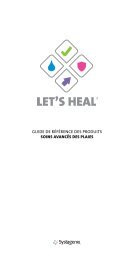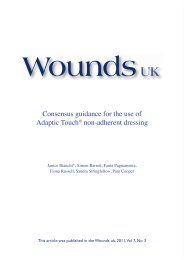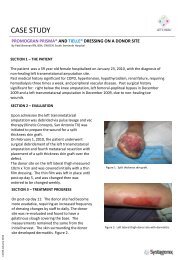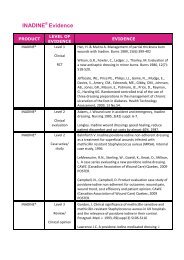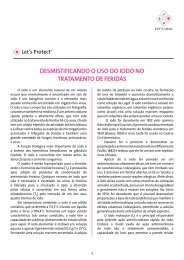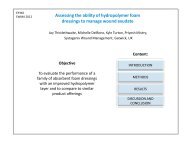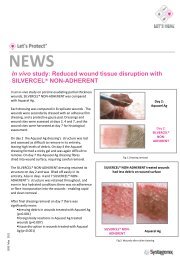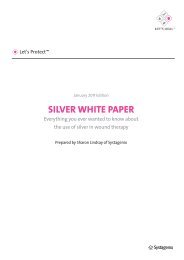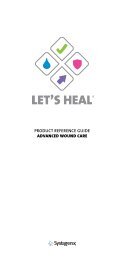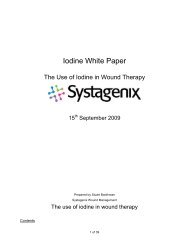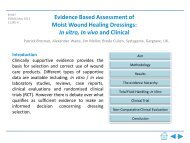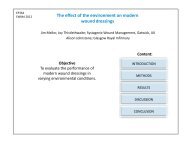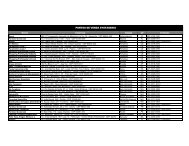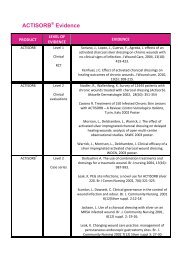USING ADAPTIC TOUCH® Non-Adhering Silicone ... - Systagenix
USING ADAPTIC TOUCH® Non-Adhering Silicone ... - Systagenix
USING ADAPTIC TOUCH® Non-Adhering Silicone ... - Systagenix
You also want an ePaper? Increase the reach of your titles
YUMPU automatically turns print PDFs into web optimized ePapers that Google loves.
<strong>ADAPTIC</strong> TOUCH® <strong>Non</strong>-<strong>Adhering</strong> <strong>Silicone</strong> Dressing<br />
This document has been<br />
jointly developed by Wounds<br />
International and <strong>Systagenix</strong><br />
with financial support from<br />
<strong>Systagenix</strong>.<br />
For further information about<br />
<strong>Systagenix</strong> please visit:<br />
www.systagenix.com<br />
Published by:<br />
Wounds International<br />
Enterprise House<br />
1–2 Hatfields<br />
London SE1 9PG, UK<br />
Tel: + 44 (0)20 7627 1510<br />
Fax: +44 (0)20 7627 1570<br />
info@woundsinternational.com<br />
www.woundsinternational.com<br />
ABOUT THIS DOCUMENT<br />
This document contains a series of case reports describing the use of<br />
<strong>ADAPTIC</strong> TOUCH® <strong>Non</strong>-adhering <strong>Silicone</strong> Dressing (<strong>Systagenix</strong>) in<br />
patients with a range of wound types. All patients were treated for a<br />
minimum of 2–4 weeks and the decision to continue with <strong>ADAPTIC</strong><br />
TOUCH® was based on continual assessment. A formal assessment<br />
was performed weekly, although in some cases dressing changes were<br />
carried out more frequently.<br />
All patients were assessed for:<br />
■■<br />
clinical signs of infection/critical colonisation<br />
■■<br />
signs of improvement, including granulation extent and reduction in<br />
wound size.<br />
A pain assessment was carried out at the initial examination using a<br />
visual analogue scale (VAS) where 1 = no pain and 10 = unbearable<br />
pain.<br />
No<br />
pain<br />
Distressing<br />
pain<br />
Unbearable<br />
pain<br />
The case reports presented in<br />
this document are the work<br />
of the authors and do not<br />
necessarily reflect the opinions<br />
of <strong>Systagenix</strong>.<br />
How to cite this document:<br />
International case series:<br />
Using <strong>ADAPTIC</strong> TOUCH®<br />
<strong>Non</strong>-<strong>Adhering</strong> <strong>Silicone</strong> Dressing:<br />
Case Studies. London: Wounds<br />
International, 2013.<br />
1 2 3 4 5 6 7 8 9 10<br />
Photographs were taken weekly in the majority of cases to document<br />
wound progression. Relevant additional wound treatments, such as<br />
compression therapy, antibiotic therapy, analgesia, etc were reported.<br />
The clinicians undertaking the study were also asked to rate the<br />
dressing (from highly satisfied to dissatisfied) and to comment on the<br />
ease of use.<br />
In addition, clinicians were offered the opportunity to check the<br />
protease activity in the wound using a WOUNDCHEK Protease Status<br />
test (<strong>Systagenix</strong>).<br />
The weekly assessment outcomes are cited for each case where:<br />
= reduction = increase — = no change.<br />
ii | INTERNATIONAL CASE STUDIES


